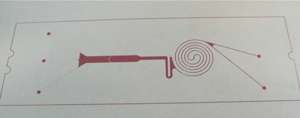Infrared treatment allows manufacture of tiny devices without damaging polymer components

Microfluidic devices are allowing microelectronic engineers to shrink laboratories to the size of a computer chip. By ferrying reagents through a series of microscopic channels and reservoirs carved into a flat plate, researchers can develop new chemical reactions or monitor the cellular effects of drugs on a much smaller scale, potentially saving time and money.
Some of these microfluidic devices even have electrical components that act as heaters or sensors, for example. But researchers have struggled to develop a rapid, low-cost method for creating the detailed metal patterns that make up these circuits.
Conventional techniques tend to require high-temperature processing, which can damage the transparent polymers typically used to build microfluidic devices, such as polycarbonate (PC) or poly(methyl methacrylate) (PMMA). Despite this drawback, the polymers are preferred over more robust alternatives because they "have very good optical properties, which most microfluidic devices require, and they are viable for plastic injection molding, which enables high-volume production," explains Zhaohong Huang of the A*STAR Singapore Institute of Manufacturing Technology.
Huang and his co-workers developed an alternative process that avoids exposing the polymers to high temperatures, and used it to build complex metal-patterned microfluidic devices (see image). They first covered sheets of PC or PMMA with thin layers of chromium, copper and nickel, and added a coating of a light-sensitive material called a photoresist. At this stage, the 'sandwich' would normally be baked at around 100 °C to remove any residual solvents after the coating process. But these temperatures would soften and warp the polymer, potentially cracking or loosening the metal layer.
Instead, Huang's team used infrared heating elements to eliminate the solvents. The metal layer acted as a protective barrier, reflecting more than 95% of any infrared radiation that hit it, meaning that the radiation warmed the photoresist layer but not the polymer beneath.
The researchers then used standard photolithography processes to create the microfluidic device. They placed a patterned mask over the sandwich and shone ultraviolet light to erode some areas of the photoresist; then, they etched away the exposed areas of metal beneath using a wash of chemicals. Stripping off any remaining photoresist left a clean metal pattern, which had features as small as 10 micrometers in width.
"If the surface finish is gold, our method can cut costs by more than 90%," says Huang. His team is now refining the process, and creating patterns of different metals with catalytic properties, which could speed up chemical reactions inside microfluidic devices.
More information: Huang, Z. H., Lim, B. C. & Wang, Z. F. Process development for high precision metal patterning on low glass transition polymer substrates. Microelectronic Engineering 98, 528–531 (2012). www.sciencedirect.com/science/ … ii/S0167931712003358



















